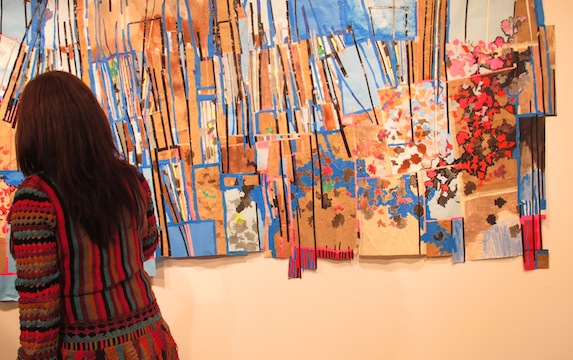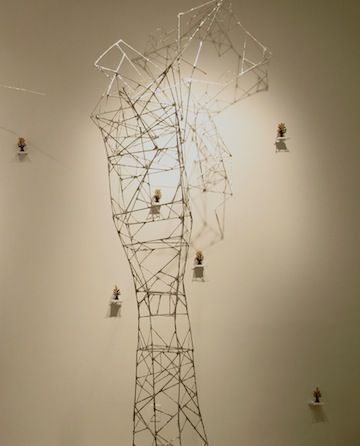
Beautiful trash, through the eyes of artist Carrie Dickason
On one of the first legitimately cold and snowy nights this Detroit winter, I had the pleasure of attending the opening reception of Carrie Dickason’s “Second Nature” at A Public Pool, the Hamtramck-area gallery. The work on display was a colorful and lively grouping, comprised mainly of discarded materials, such as plastic containers that once housed children’s toys or the packaging of store-bought food items, on which you can still read the nutrition information. The risk in writing about the work — as well as in making it — is in getting too caught up explaining what it “means” to use discarded materials, and thereby losing sight — literally — of the work itself.
Upon walking into the space, I became quickly enamored with the show’s centerpiece, a bright, hand-constructed tree standing in the middle of the gallery (“Family Tree”). The beauty of the piece struck me on an immediate, visceral level. It was only after I’d absorbed its impact that I began to think about the broader implications of the artist’s choice of materials, in this case gold-painted plastic toy containers forming the leaves of the tree.
The other piece that caught my attention (“Untitled (Fuchsia)”), was a brilliantly colored, large, hanging work, which Dickason described to me as “process-oriented,” involving the cutting and recombining of paper, leaves and paint. Created on the wall of a barn in Vermont, the artist told me she was attempting “to create a window where there wasn’t one,” which is probably one of the greatest reasons for creating art I’ve ever heard.
In discussing the show, Dickason expressed a concern that her work — in many ways a sharp critique of consumer culture — was somehow inadvertently elevating the consumer objects themselves, by making them attractive to look at. I certainly don’t have an answer to that question and, instead, would like to encourage the reader to make up their own mind by finding their way to the gallery and spending some quality time with the artwork. However, I will add that many of our everyday objects — from plastic bottles to plastic food containers to plastic utensils — simply pass through our hands beneath our notice. Whether these items should exist or not — either as objects of shameful scorn or as admirable technological marvels — is a question we can’t even begin to think about without first noticing the objects themselves. And noticing these objects, even obsessing over them, is precisely where Dickason’s work truly excels.
After the show, I was able to ask Dickason a few questions. The result of our conversation follows.
Jeremy Schmall: Right now you’re working in Detroit, but you’ve also worked in Santa Fe, Vermont and elsewhere. Do you find that your process changes depending on your location?
Carrie Dickason: A few years ago I realized I’m attracted to the same types of things here as I am in rural and coastal landscapes — intersecting areas of erosion and growth. Wherever I am, I glean from the local landscape, collecting and experimenting with whatever materials are available. I think of my process as a sort of cultivation. It involves a lot of cutting and splicing, shifting and layering, building up and tearing down. Here, I’m particularly interested in the handpainted signage and the construction materials used in old buildings. Lately, I’ve been thinking about using bricks and would like to move into more permanent work that can exist outside.
JS: Are there any materials you enjoy using the most?
CD: I like common materials that are used by many people and are collected by a group. I’ve used plastic packaging since the mid-’90s when I was studying textiles and became sensitive to the chemicals used in the dye lab. Plastic packaging comes with its own palette and is very versatile. It’s a substance that we all can relate to in some way, and, because of that, it’s approachable for a broad audience.
JS: You mentioned that you’re unsure whether your use of discarded consumer packaging isn’t accidentally glorifying these objects. What did you mean by that?
CD: I’m fascinated with the relationship humans have with trash — we go to great lengths to create it: people make their livings designing packaging, mining the materials, building factories, designing and fabricating machinery, etc. There are so many levels of technology that need to exist in order to produce something that eventually gets thrown away. Our trash is actually a result of an advanced society, and it can be really beautiful — it was designed to attract in the first place. I think that my use of the packaging fulfills an impulse to collect and construct, while processing my own conflicting attitudes toward the stuff. I love it and hate it.
JS: You have a really interesting job, in that it exists at a weird overlap of artisanal skill, high-end consumerism and the automotive industry. Could you explain what you do and how you feel about it?
CD: I work at HOF Designs, a trim shop that does interior upholstery restoration for Porsches, Corvettes, Mercedes, etc. I cut and sew floor mats; hand-lace steering wheels, shifters and visors; trace and cut seat patterns from leather. I have a lot of conflicting feelings about the work. The attention to detail and level of perfection is incredible — the handwork must be so perfect as to seem mechanical, yet much of it is not even visible once installed in the car. Last week we were disassembling a Porsche interior and found an ATM deposit slip for $90,000. That is simply incredible to me, such an economic scale shift from my reality. It’s hard to comprehend, especially in light of where we live and the state of the economy as a whole.
All photos by Sarah Sharp. “Second Nature” runs until Feb. 25 at A Public Pool: 3309 Caniff, Hamtramck, 313.405.7665, apublicpool.com.
Recent Content
-
Artsarticle ·
-
Artsarticle ·
-
Artsarticle ·



